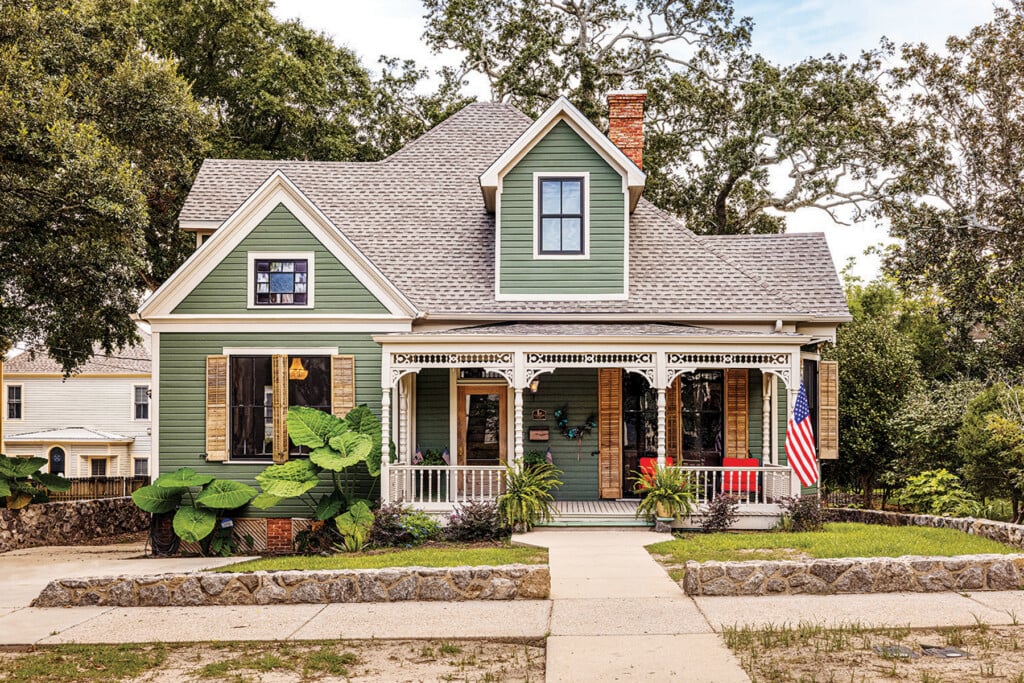Homeowners Preserving History
Historic Pensacola fixer-uppers fall beyond buyers’ DIY abilities; local architect helps bring vision to fruition

When Lisa Long Lyter and her husband, Tommi, purchased their folk Victorian on the edge of Pensacola’s historic North Hill neighborhood in January 2021, the old house had seen far better days. “It was a mess, quite honestly, and there was a big hole in the floor,” Lisa says. “My husband, we walked upstairs, and he was like, ‘Oh, it feels kind of murdery up here.’ That’s how bad it was.” The Lyters’ architect, Scott Sallis, has similar recollections. “It was a scary, dark, moldy place,” he says of the home, which was originally built in 1897 by contractor Charles Turner. “But it was only dark because all the windows were boarded up. The bones of that house were made to bring light in.”
And Sallis, who owns Dalrymple Sallis Architecture (DSA) with partner Dean Dalrymple in downtown Pensacola, would know. A leader in historic restoration across the Pensacola area, DSA is widely known for its commitment to the preservation of historic buildings, including its own Government Street office, which was once a 1947 grocery store.
“What I liked about Lisa’s house was that it was so bad we could go nowhere but up,” he says. “I mean, just showing up was going to be life changing. It was exciting because it was like, ‘How high can we go?’ And it would be on their dreams and budget.”
The Lyters had only been married two months when they bought the North Hill home. When they discovered that Turner originally built it for his sister as a wedding gift—and that it had been known as The Wedding Cottage—bringing it back to life felt somewhat fated.
“And so, it was my husband’s and my story,” Lisa says. “By pouring into the old, I am preserving history. I’m not writing a book. I’m not making a movie. I am preserving a home.”
To bring Sallis’ designs to life, the Lyters turned to builder Nannette Chandler. Heading up Chandler & Company Construction, she has worked in restoration for more than 20 years, taking on her first old house at the age of 19 and now spending half her time on historic rebuilds.
“You really have to go back to the bones of the house, so with Lisa’s house, that’s what we did,” Chandler says. “We wanted the house to maintain that beautiful character that draws us to it, but we needed it to function for modern living.”
One small example of that approach was Chandler’s effort to salvage game day for Tommi while still honoring the house’s history.
“Lisa’s husband, he loves his TV,” she says. “He wants to watch his games—he wants what he wants, and there’s nothing wrong with that.”
But Chandler couldn’t bear the thought of making a modern flat-screen TV the focal point of the old home’s gorgeous open and airy living-dining-kitchen space.
“I said, ‘OK, we will recess the TV into the ceiling,’” she says. “You can hit it with a remote whenever you’re entertaining.”
The clever fix was a hit all around.
“What we ended up with is a feature that everybody absolutely loves,” Chandler says. “And whenever you walk into that house, it’s not the focal point because it never was the focal point originally.”
A larger example of balancing the old and the new was Sallis and Chandler’s decision to turn the one-story home’s giant attic—which peaks at 18 feet—into a fully modern second story, complete with a staircase, three bedrooms, two bathrooms, living room, and laundry.
“All those nooks and crannies in these houses, all of that is usable space,” Chandler says. “A lot of people will purchase an old house, and they’ll be like, Oh, well, there’s not a lot of space, and we don’t like the layout,’ and they’re forgetting, like, look above your head!”
Though the second floor presented new challenges, Sallis and Chandler were continually prepared to pivot. Sallis designed dozens of additional piers to be built underneath the house to accommodate the extra weight at the top. Chandler salvaged wood from the attic’s discarded collar ties as well as another old building from the same time period to craft stair treads that matched the first story’s original flooring.
Sallis said it’s that kind of creativity and patience paired with knowledge and expertise that can make the difference between a successful and not-so-successful restoration.
“It takes partners like Nanette, who are not afraid of difficulty because there’s no restoration anywhere on the planet that’s easy,” Sallis says. “Most successful builders have that guy who’s not afraid to get their hands dirty with crafting things with metal or wood, but it’s becoming more and more rare.”
Across the country, Sallis says, the labor pool of skilled and knowledgeable craftsmen is shrinking rapidly, making historic restoration more expensive and more difficult to accomplish.
“Older construction is built in a way to last inherently with limited tools,” he says. “In other words, that thing that you’re going to restore, it probably wasn’t even built with nails. It definitely wasn’t built with glue or screws.”
For Stephen and Bridget Fluegge, Sallis’ redesign for the restoration of their 1885 historic Southern coastal cottage in downtown Pensacola required craftsmen who knew how to work with the strongest heart pine. The small one-bedroom, one-and-a-half-bath cottage, with its nearly 12-foot ceilings needed the front porch unexpectedly rebuilt and a back porch extended for recreational use.
“One of the things that I would stress is that these are not beginner projects,” Stephen says. “This is not do-it-yourself. You need to get expert people involved who have done it before and have a good track record.”
In fact, Sallis says restoration projects are like a three-legged stool—comprised of the homeowner, architect, and builder—that is strongest when there’s open and honest communication.
“My favorite client is a trusting one,” he says. “And I mean that because if they’ll trust, then everything goes well.”
That three-legged stool is so important to Chandler that she gives every client the same speech at the outset of a historic rebuild.
“We are going to be in a relationship for the next nine months; we are going to talk to each other every single workday,” she says. “I’m going to say, ‘Here’s the crazy stuff we found, everything went smoothly, whatever.’ We’re going to see each other multiple times a week, at minimum. We really need to like each other! It’s a lighthearted conversation, but I let them know I’m 100 percent not joking.”
The Lyters wholeheartedly agree. By the end of their two-year rebuild, which was delayed by pandemic supply chain snarls, they were thrilled not only with the house’s transformation but also the new relationships they had forged.
“We had an amazing experience with Scott and Nanette,” Lisa says. “We just had fun, and Nannette’s team became friends of ours because they were in the house every day. My husband would drive by every morning to look at the house on his way to work, and sometimes at lunch, he would take people in just to check on it. He was, you know, just obsessed with it.”
Today, all the scary, dark, and moldy vibes have been replaced with light and laughter and a true sense of place.
“I love the whole house, I love the openness,” Lisa says. “We put, I think it’s a 10-foot, maybe 11-foot bar in the kitchen, where it’s this big space where people can sit and eat and enjoy. It’s a great place to come home to every night.”





